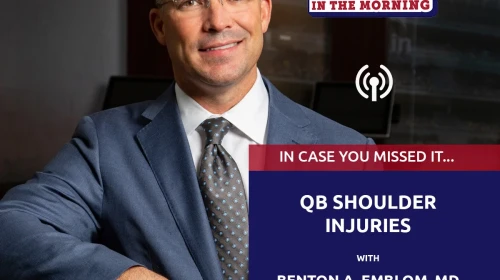The acromioclavicular (AC) joint is located at the top of the shoulder between the clavicle (collarbone) and acromion (part of the shoulder blade that forms the hard, bony region on the top of the shoulder).
What is it?
This is an injury of the acromioclavicular joint (commonly called the "AC" joint). This is the joint where clavicle meets the scapula. A shoulder separation is a stretching or tearing of the ligaments that support these bones. This allows the bones to move out of position. An AC joint separation is commonly referred to as a separated shoulder, which is not related to a dislocated shoulder. Several grades of injuries can occur. Grades I-III are the most common, but AC joint separations can be classified all the way up to a Grade VI injury.
What causes it?
A separated shoulder is most commonly caused by traumatic injury. It can happen if you fall on your shoulder, or if you are struck on the point of your shoulder. Athletes who play contact sports such as football and hockey are susceptible to this injury. So are skiers and gymnasts. The lowest grade, Grade I, is caused by a partial tear in the AC ligament. Grade II occurs when the AC ligament ruptures and the CC ligament remains intact. This causes a partial dislocation of the AC joint. Grade III is a complete separation of the joint and both the AC and CC ligaments are completely torn. This leads to an inferior displacement (downward) of the shoulder from its original position and the clavicle rising up and forming a bump in the skin. AC joint separations are commonly caused by trauma to the shoulder like a direct blow to the shoulder pads in football, a cyclist falling at high speeds, or other harsh falls onto the “point” of the shoulder by athletes with an extended arm. An AC joint separation causes pain in the front and top of the shoulder and is exacerbated when reaching upward.
Signs and Symptoms
Symptoms may include pain and weakness in your shoulder. You may not be able to move your shoulder through its full range of motion. You may have bruising and swelling. Your shifted clavicle may create a visible bump beneath your skin.
Non-Surgical Treatment
Treatment options include rest, ice and medications. Your arm may be placed in a sling. You may benefit from physical therapy. Nonoperative treatments of immobilization, ice, and anti-inflammatory drugs are recommended for Grade I-III separations.
Surgical Treatment
A severe injury may require surgical repair. Higher grade separations are caused by extreme dislocation of the clavicle that can disrupt shoulder muscles and tendons, and it may require surgery to repair or reconstruct the ligaments. Your healthcare provider can create a plan thats right for you.
At The Shoulder Center at Andrews Sports Medicine, our fellowship-trained non-surgical physicians and orthopaedic surgeons provide the most-advanced, comprehensive treatment solutions for injuries and disorders of the shoulder. To schedule an appointment, call (205) 939-3699.
Request an Appointment OnlineBack to Shoulder








